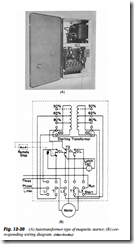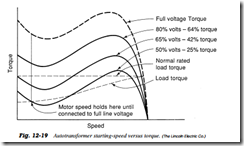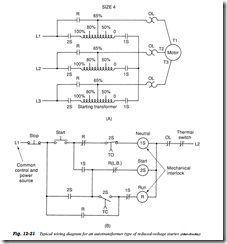AUTOTRANSFORMER STARTING
Autotransformer starters provide reduced voltage starting at the motor terminals through the use of a tapped, three phase autotransformer. Upon initiation of the controller pilot device, a two and a three pole contactor close to connect the motor to the preselected autotransformer taps. A timing relay causes the transfer of the motor from the reduced voltage start to line voltage operation without disconnecting the motor from the power source. This is known as closed transition starting
Taps on the autotransformer provide selection of 50%, 65%, or 80% of line voltage as a starting voltage. Starting torque will be 25%, 42%, or 64%, respectively, of line voltage values. However, because of transformer action, the controller line current will be less than motor current, being 25%, 42%, or 64% of full voltage values. This autotransformer starting may be used to provide maximum torque available with minimum line current, together with taps to permit both of these factors to be varied. Figure 12 19 shows torque and voltage tap points.
Manual autotransformer starters are used to start squirrel cage polyphase motors when the characteristics of the driven load or power company limitations require starting at reduced voltage (Fig. 12 20)
NEMA (National Electrical Manufacturers Association) permits one start every 4 minutes, for a total of four starts followed by a rest period (2 hours). Each starting period is not to exceed 15 seconds. Figure 12 21 shows a autotransformer type of starter. Note the location of the taps on the starting transformer.
The autotransformer provides the highest starting torque per ampere of line current. Thus it is an effective means of motor starting for applications where the inrush current must be reduced with a minimum sacrifice of starting torque. This type of starter arrangement features closed circuit transition, an arrangement that maintains a continuous power connection to the motor during the transition from reduced to full voltage. This avoids the high transient switching currents characteristic of starters using open circuit transition. It provides smoother acceleration as well.
Operation
Operating an external start button or pilot device closes the neutral and start contactors, applying reduced voltage to the motor through the autotransformer. After a preset interval, the timer contacts drop out the neutral contactor, breaking the autotransformer connection but leaving part of the windings connected to the motor as a series reactor. The run contactor then closes to short out this reactance and apply full voltage to the motor. Transition from reduced to full voltage is accomplished without opening the motor circuit
For starters rated up to 200 hp you should allow a 15 second operation out of every 4 minutes. This procedure is followed for 1 hour with a rest period of 2 hours. For starters rated above 200 hp, you should allow three 30 second operations separated by 30 second intervals followed by a rest period of 1 hour. The major disadvantages of this type of starter are its expense for lower horsepower ratings and its low power factor


